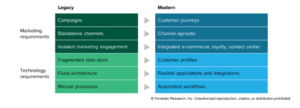Welcome To The Future Of Marketing Technology
To meet customers in their moments, marketers must design, execute, and optimize interactions across the full range of devices, channels, and touchpoints where consumers engage with a brand. Meanwhile, the marketing landscape continues to evolve with new technologies, data deprecation, and sophisticated consumers. An effective martech strategy supports the needs of marketing today while retaining the flexibility to adapt to future needs.
Martech Struggles To Meet Next-Gen Requirements Despite Steady Investment
Though marketing technology remains resilient with significant support and investment from enterprises, it struggles to keep pace with evolving marketing requirements. Marketers are in the difficult position of constantly updating and stretching legacy technologies to accommodate a highly dynamic environment.
The challenge has become increasingly acute in the last couple years as martech’s remit expands to support interactions across the customer lifecycle in more touchpoints, yet martech remains technically complex and subject to unprecedented scrutiny from a growing cast of stakeholders as firms navigate economic headwinds.
Clearly, marketing needs an approach that breaks the cycle of building for short-term needs at the expense of tomorrow. Constantly adding new applications and data systems on top of legacy martech is unsustainable because it is expensive, disconnected, and reactive. And consumers can tell the difference.
Marketers Must Shift From “Stacks” To An Ecosystem Approach
In our recently published report, The Future Of Marketing Technology, we lay out a new approach: Modernizing martech requires an ecosystem approach. A generation of consolidation-focused strategies have clearly fallen short; now marketers must embrace the unbundling of martech and adopt a new strategy capable of supporting the shift from legacy, channel-centric, campaign-oriented tactics to channel-agnostic, journey-oriented engagement.

Forrester defines a marketing technology ecosystem as: an interconnected system of data, applications, and services that enables consumer marketing strategy, insights, and engagement.
The martech ecosystem prioritizes four strategic capabilities:
- Marketers need integration, workflow, and data connectivity so that components across the ecosystem operate as a cohesive unit rather than a portfolio of tools.
- Marketers need data for customer profiles as well as data streaming functionality for real-time applications, connectivity to data management and enrichment sources, and identity resolution services.
- Marketers need a unified facility for creating target audiences, assembling communications, and triggering interactions to centralize all touchpoints and customer lifecycle phases.
- AI-driven martech capabilities will expand into automating customer insights, streamlining marketing operations, and generating customer journeys.
An Ecosystem Approach Is More Than The Sum Of Its Functionality
The ecosystem is a philosophical pivot that positions the martech stack in terms of outputs rather than a collection of product features. The benefits are numerous; marketers can maximize flexibility, build the system over time, reduce dependence on external providers, and adapt capabilities to company-specific needs. Firms that can reorient their martech strategy to an ecosystem approach, along with the requisite governance and planning, tech partnerships, and data strategy, will position themselves for success both today and in the future.
To continue the conversation, request an inquiry or guidance session to learn more about the ecosystem approach to martech strategy.
